Managing Financial Resources and Decisions: A Comprehensive Report
VerifiedAdded on 2020/01/06
|17
|5094
|110
Report
AI Summary
This report examines the critical aspects of managing financial resources and making sound financial decisions. It begins by identifying and evaluating various sources of finance, including venture capital, angel investments, and financing from banking institutions, assessing their implications and costs. The report emphasizes the importance of financial planning, particularly cash management, for small businesses. It then assesses the information needs of decision-makers, both internal (management and employees) and external (regulatory authorities and customers). The impact of finance on financial statements is analyzed, and the report delves into preparing cash budgets, making pricing decisions, calculating unit costs, and assessing project viability using techniques like payback period, ARR, and NPV. The report also discusses the main financial statements and the interpretation of financial ratios, providing a comprehensive overview of financial management principles and practices.

Managing Financial Resources
and Decisions
and Decisions
Paraphrase This Document
Need a fresh take? Get an instant paraphrase of this document with our AI Paraphraser
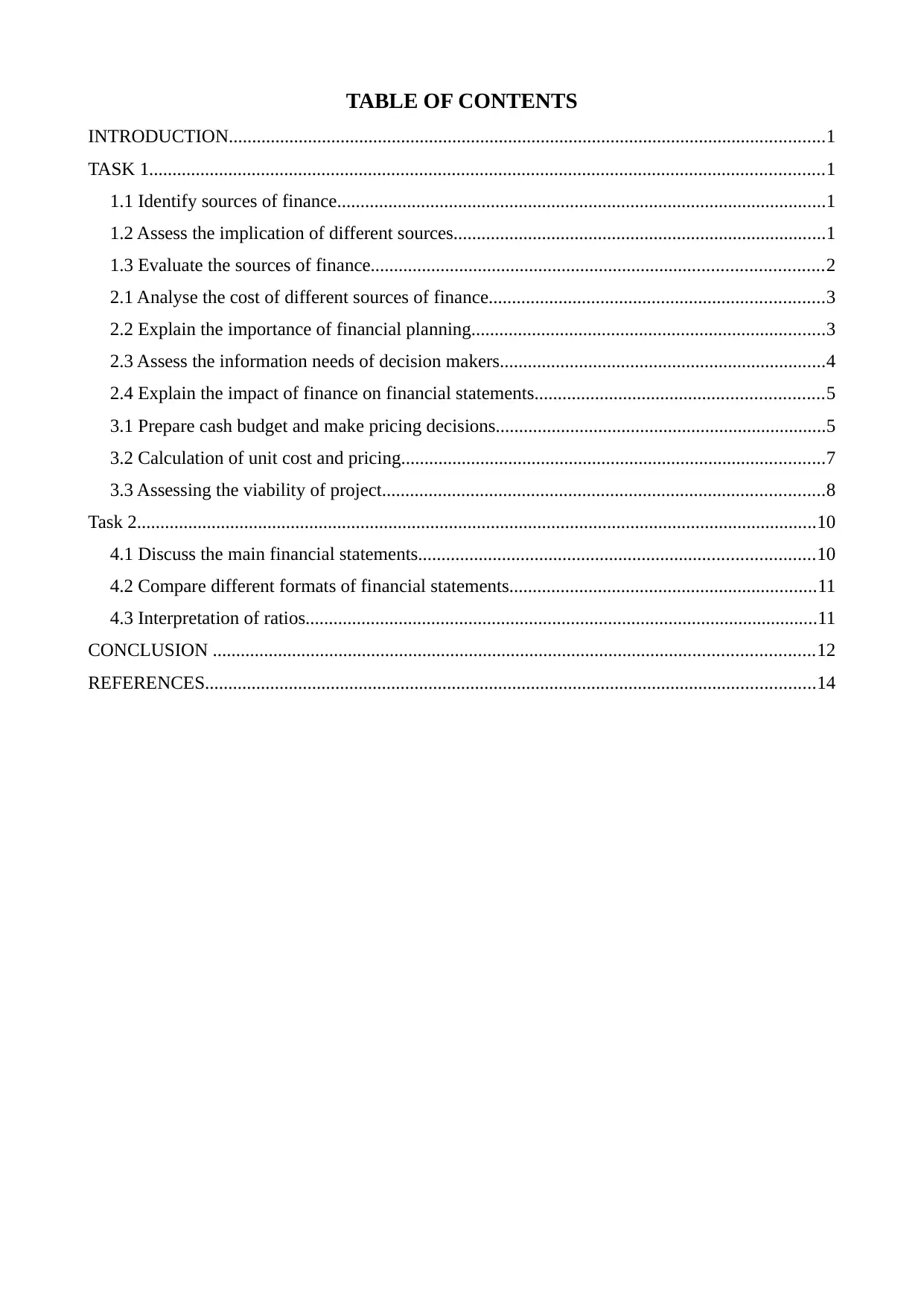
TABLE OF CONTENTS
INTRODUCTION................................................................................................................................1
TASK 1.................................................................................................................................................1
1.1 Identify sources of finance.........................................................................................................1
1.2 Assess the implication of different sources................................................................................1
1.3 Evaluate the sources of finance.................................................................................................2
2.1 Analyse the cost of different sources of finance........................................................................3
2.2 Explain the importance of financial planning............................................................................3
2.3 Assess the information needs of decision makers......................................................................4
2.4 Explain the impact of finance on financial statements..............................................................5
3.1 Prepare cash budget and make pricing decisions.......................................................................5
3.2 Calculation of unit cost and pricing...........................................................................................7
3.3 Assessing the viability of project...............................................................................................8
Task 2..................................................................................................................................................10
4.1 Discuss the main financial statements.....................................................................................10
4.2 Compare different formats of financial statements..................................................................11
4.3 Interpretation of ratios..............................................................................................................11
CONCLUSION .................................................................................................................................12
REFERENCES...................................................................................................................................14
INTRODUCTION................................................................................................................................1
TASK 1.................................................................................................................................................1
1.1 Identify sources of finance.........................................................................................................1
1.2 Assess the implication of different sources................................................................................1
1.3 Evaluate the sources of finance.................................................................................................2
2.1 Analyse the cost of different sources of finance........................................................................3
2.2 Explain the importance of financial planning............................................................................3
2.3 Assess the information needs of decision makers......................................................................4
2.4 Explain the impact of finance on financial statements..............................................................5
3.1 Prepare cash budget and make pricing decisions.......................................................................5
3.2 Calculation of unit cost and pricing...........................................................................................7
3.3 Assessing the viability of project...............................................................................................8
Task 2..................................................................................................................................................10
4.1 Discuss the main financial statements.....................................................................................10
4.2 Compare different formats of financial statements..................................................................11
4.3 Interpretation of ratios..............................................................................................................11
CONCLUSION .................................................................................................................................12
REFERENCES...................................................................................................................................14

INDEX OF TABLES
Table 1: Calculation of Unit cost..........................................................................................................5
Table 2: Calculation of selling price.....................................................................................................6
Table 3: Calculating cash flow of project.............................................................................................6
Table 4: Calculation of Pay back period..............................................................................................7
Table 5: Calculation of ARR................................................................................................................8
Table 6: Calculation of NPV................................................................................................................8
Table 7: Ratio analysis of Marriott international................................................................................10
Table 1: Calculation of Unit cost..........................................................................................................5
Table 2: Calculation of selling price.....................................................................................................6
Table 3: Calculating cash flow of project.............................................................................................6
Table 4: Calculation of Pay back period..............................................................................................7
Table 5: Calculation of ARR................................................................................................................8
Table 6: Calculation of NPV................................................................................................................8
Table 7: Ratio analysis of Marriott international................................................................................10
⊘ This is a preview!⊘
Do you want full access?
Subscribe today to unlock all pages.

Trusted by 1+ million students worldwide
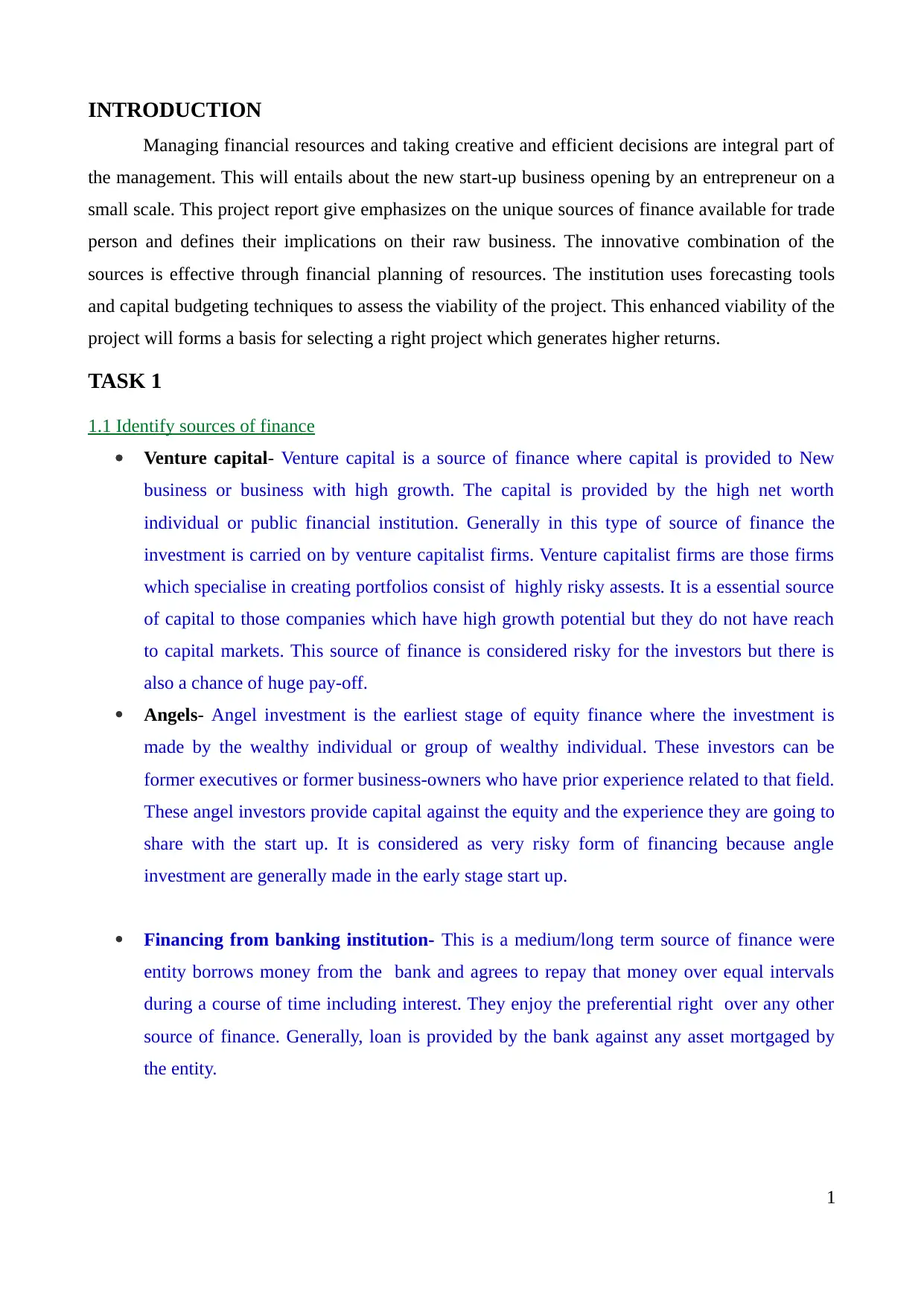
INTRODUCTION
Managing financial resources and taking creative and efficient decisions are integral part of
the management. This will entails about the new start-up business opening by an entrepreneur on a
small scale. This project report give emphasizes on the unique sources of finance available for trade
person and defines their implications on their raw business. The innovative combination of the
sources is effective through financial planning of resources. The institution uses forecasting tools
and capital budgeting techniques to assess the viability of the project. This enhanced viability of the
project will forms a basis for selecting a right project which generates higher returns.
TASK 1
1.1 Identify sources of finance
Venture capital- Venture capital is a source of finance where capital is provided to New
business or business with high growth. The capital is provided by the high net worth
individual or public financial institution. Generally in this type of source of finance the
investment is carried on by venture capitalist firms. Venture capitalist firms are those firms
which specialise in creating portfolios consist of highly risky assests. It is a essential source
of capital to those companies which have high growth potential but they do not have reach
to capital markets. This source of finance is considered risky for the investors but there is
also a chance of huge pay-off.
Angels- Angel investment is the earliest stage of equity finance where the investment is
made by the wealthy individual or group of wealthy individual. These investors can be
former executives or former business-owners who have prior experience related to that field.
These angel investors provide capital against the equity and the experience they are going to
share with the start up. It is considered as very risky form of financing because angle
investment are generally made in the early stage start up.
Financing from banking institution- This is a medium/long term source of finance were
entity borrows money from the bank and agrees to repay that money over equal intervals
during a course of time including interest. They enjoy the preferential right over any other
source of finance. Generally, loan is provided by the bank against any asset mortgaged by
the entity.
1
Managing financial resources and taking creative and efficient decisions are integral part of
the management. This will entails about the new start-up business opening by an entrepreneur on a
small scale. This project report give emphasizes on the unique sources of finance available for trade
person and defines their implications on their raw business. The innovative combination of the
sources is effective through financial planning of resources. The institution uses forecasting tools
and capital budgeting techniques to assess the viability of the project. This enhanced viability of the
project will forms a basis for selecting a right project which generates higher returns.
TASK 1
1.1 Identify sources of finance
Venture capital- Venture capital is a source of finance where capital is provided to New
business or business with high growth. The capital is provided by the high net worth
individual or public financial institution. Generally in this type of source of finance the
investment is carried on by venture capitalist firms. Venture capitalist firms are those firms
which specialise in creating portfolios consist of highly risky assests. It is a essential source
of capital to those companies which have high growth potential but they do not have reach
to capital markets. This source of finance is considered risky for the investors but there is
also a chance of huge pay-off.
Angels- Angel investment is the earliest stage of equity finance where the investment is
made by the wealthy individual or group of wealthy individual. These investors can be
former executives or former business-owners who have prior experience related to that field.
These angel investors provide capital against the equity and the experience they are going to
share with the start up. It is considered as very risky form of financing because angle
investment are generally made in the early stage start up.
Financing from banking institution- This is a medium/long term source of finance were
entity borrows money from the bank and agrees to repay that money over equal intervals
during a course of time including interest. They enjoy the preferential right over any other
source of finance. Generally, loan is provided by the bank against any asset mortgaged by
the entity.
1
Paraphrase This Document
Need a fresh take? Get an instant paraphrase of this document with our AI Paraphraser
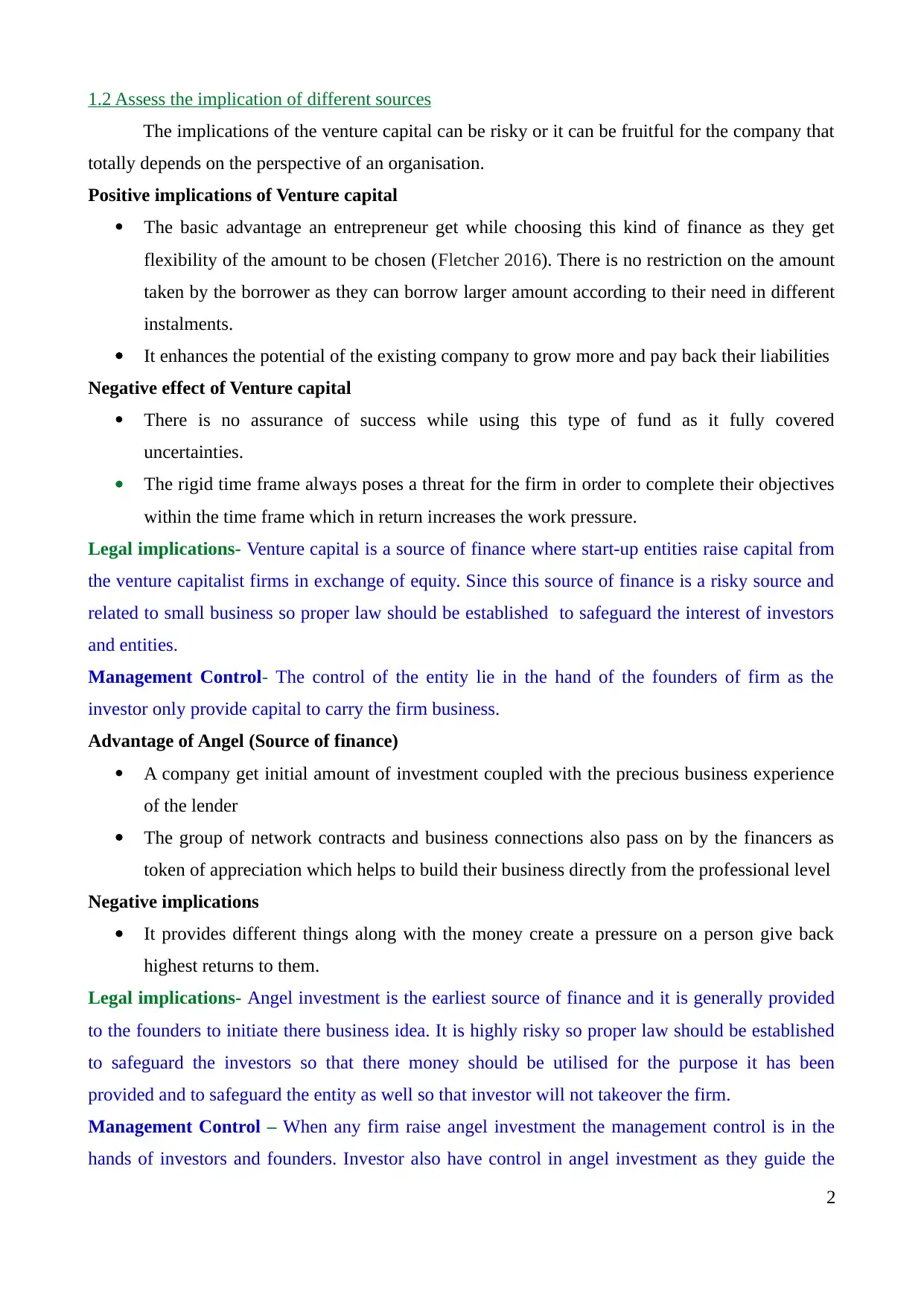
1.2 Assess the implication of different sources
The implications of the venture capital can be risky or it can be fruitful for the company that
totally depends on the perspective of an organisation.
Positive implications of Venture capital
The basic advantage an entrepreneur get while choosing this kind of finance as they get
flexibility of the amount to be chosen (Fletcher 2016). There is no restriction on the amount
taken by the borrower as they can borrow larger amount according to their need in different
instalments.
It enhances the potential of the existing company to grow more and pay back their liabilities
Negative effect of Venture capital
There is no assurance of success while using this type of fund as it fully covered
uncertainties.
The rigid time frame always poses a threat for the firm in order to complete their objectives
within the time frame which in return increases the work pressure.
Legal implications- Venture capital is a source of finance where start-up entities raise capital from
the venture capitalist firms in exchange of equity. Since this source of finance is a risky source and
related to small business so proper law should be established to safeguard the interest of investors
and entities.
Management Control- The control of the entity lie in the hand of the founders of firm as the
investor only provide capital to carry the firm business.
Advantage of Angel (Source of finance)
A company get initial amount of investment coupled with the precious business experience
of the lender
The group of network contracts and business connections also pass on by the financers as
token of appreciation which helps to build their business directly from the professional level
Negative implications
It provides different things along with the money create a pressure on a person give back
highest returns to them.
Legal implications- Angel investment is the earliest source of finance and it is generally provided
to the founders to initiate there business idea. It is highly risky so proper law should be established
to safeguard the investors so that there money should be utilised for the purpose it has been
provided and to safeguard the entity as well so that investor will not takeover the firm.
Management Control – When any firm raise angel investment the management control is in the
hands of investors and founders. Investor also have control in angel investment as they guide the
2
The implications of the venture capital can be risky or it can be fruitful for the company that
totally depends on the perspective of an organisation.
Positive implications of Venture capital
The basic advantage an entrepreneur get while choosing this kind of finance as they get
flexibility of the amount to be chosen (Fletcher 2016). There is no restriction on the amount
taken by the borrower as they can borrow larger amount according to their need in different
instalments.
It enhances the potential of the existing company to grow more and pay back their liabilities
Negative effect of Venture capital
There is no assurance of success while using this type of fund as it fully covered
uncertainties.
The rigid time frame always poses a threat for the firm in order to complete their objectives
within the time frame which in return increases the work pressure.
Legal implications- Venture capital is a source of finance where start-up entities raise capital from
the venture capitalist firms in exchange of equity. Since this source of finance is a risky source and
related to small business so proper law should be established to safeguard the interest of investors
and entities.
Management Control- The control of the entity lie in the hand of the founders of firm as the
investor only provide capital to carry the firm business.
Advantage of Angel (Source of finance)
A company get initial amount of investment coupled with the precious business experience
of the lender
The group of network contracts and business connections also pass on by the financers as
token of appreciation which helps to build their business directly from the professional level
Negative implications
It provides different things along with the money create a pressure on a person give back
highest returns to them.
Legal implications- Angel investment is the earliest source of finance and it is generally provided
to the founders to initiate there business idea. It is highly risky so proper law should be established
to safeguard the investors so that there money should be utilised for the purpose it has been
provided and to safeguard the entity as well so that investor will not takeover the firm.
Management Control – When any firm raise angel investment the management control is in the
hands of investors and founders. Investor also have control in angel investment as they guide the
2
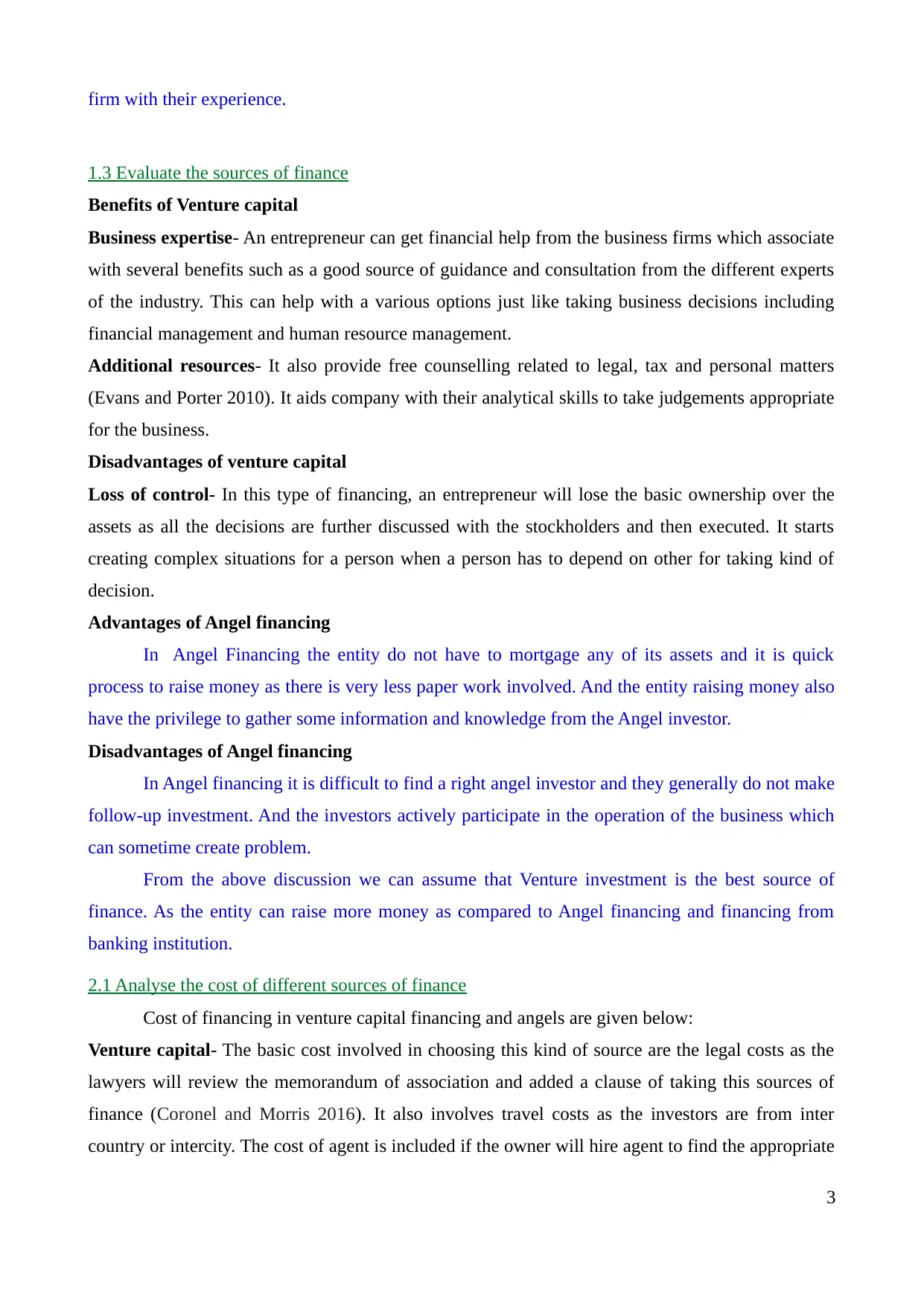
firm with their experience.
1.3 Evaluate the sources of finance
Benefits of Venture capital
Business expertise- An entrepreneur can get financial help from the business firms which associate
with several benefits such as a good source of guidance and consultation from the different experts
of the industry. This can help with a various options just like taking business decisions including
financial management and human resource management.
Additional resources- It also provide free counselling related to legal, tax and personal matters
(Evans and Porter 2010). It aids company with their analytical skills to take judgements appropriate
for the business.
Disadvantages of venture capital
Loss of control- In this type of financing, an entrepreneur will lose the basic ownership over the
assets as all the decisions are further discussed with the stockholders and then executed. It starts
creating complex situations for a person when a person has to depend on other for taking kind of
decision.
Advantages of Angel financing
In Angel Financing the entity do not have to mortgage any of its assets and it is quick
process to raise money as there is very less paper work involved. And the entity raising money also
have the privilege to gather some information and knowledge from the Angel investor.
Disadvantages of Angel financing
In Angel financing it is difficult to find a right angel investor and they generally do not make
follow-up investment. And the investors actively participate in the operation of the business which
can sometime create problem.
From the above discussion we can assume that Venture investment is the best source of
finance. As the entity can raise more money as compared to Angel financing and financing from
banking institution.
2.1 Analyse the cost of different sources of finance
Cost of financing in venture capital financing and angels are given below:
Venture capital- The basic cost involved in choosing this kind of source are the legal costs as the
lawyers will review the memorandum of association and added a clause of taking this sources of
finance (Coronel and Morris 2016). It also involves travel costs as the investors are from inter
country or intercity. The cost of agent is included if the owner will hire agent to find the appropriate
3
1.3 Evaluate the sources of finance
Benefits of Venture capital
Business expertise- An entrepreneur can get financial help from the business firms which associate
with several benefits such as a good source of guidance and consultation from the different experts
of the industry. This can help with a various options just like taking business decisions including
financial management and human resource management.
Additional resources- It also provide free counselling related to legal, tax and personal matters
(Evans and Porter 2010). It aids company with their analytical skills to take judgements appropriate
for the business.
Disadvantages of venture capital
Loss of control- In this type of financing, an entrepreneur will lose the basic ownership over the
assets as all the decisions are further discussed with the stockholders and then executed. It starts
creating complex situations for a person when a person has to depend on other for taking kind of
decision.
Advantages of Angel financing
In Angel Financing the entity do not have to mortgage any of its assets and it is quick
process to raise money as there is very less paper work involved. And the entity raising money also
have the privilege to gather some information and knowledge from the Angel investor.
Disadvantages of Angel financing
In Angel financing it is difficult to find a right angel investor and they generally do not make
follow-up investment. And the investors actively participate in the operation of the business which
can sometime create problem.
From the above discussion we can assume that Venture investment is the best source of
finance. As the entity can raise more money as compared to Angel financing and financing from
banking institution.
2.1 Analyse the cost of different sources of finance
Cost of financing in venture capital financing and angels are given below:
Venture capital- The basic cost involved in choosing this kind of source are the legal costs as the
lawyers will review the memorandum of association and added a clause of taking this sources of
finance (Coronel and Morris 2016). It also involves travel costs as the investors are from inter
country or intercity. The cost of agent is included if the owner will hire agent to find the appropriate
3
⊘ This is a preview!⊘
Do you want full access?
Subscribe today to unlock all pages.

Trusted by 1+ million students worldwide
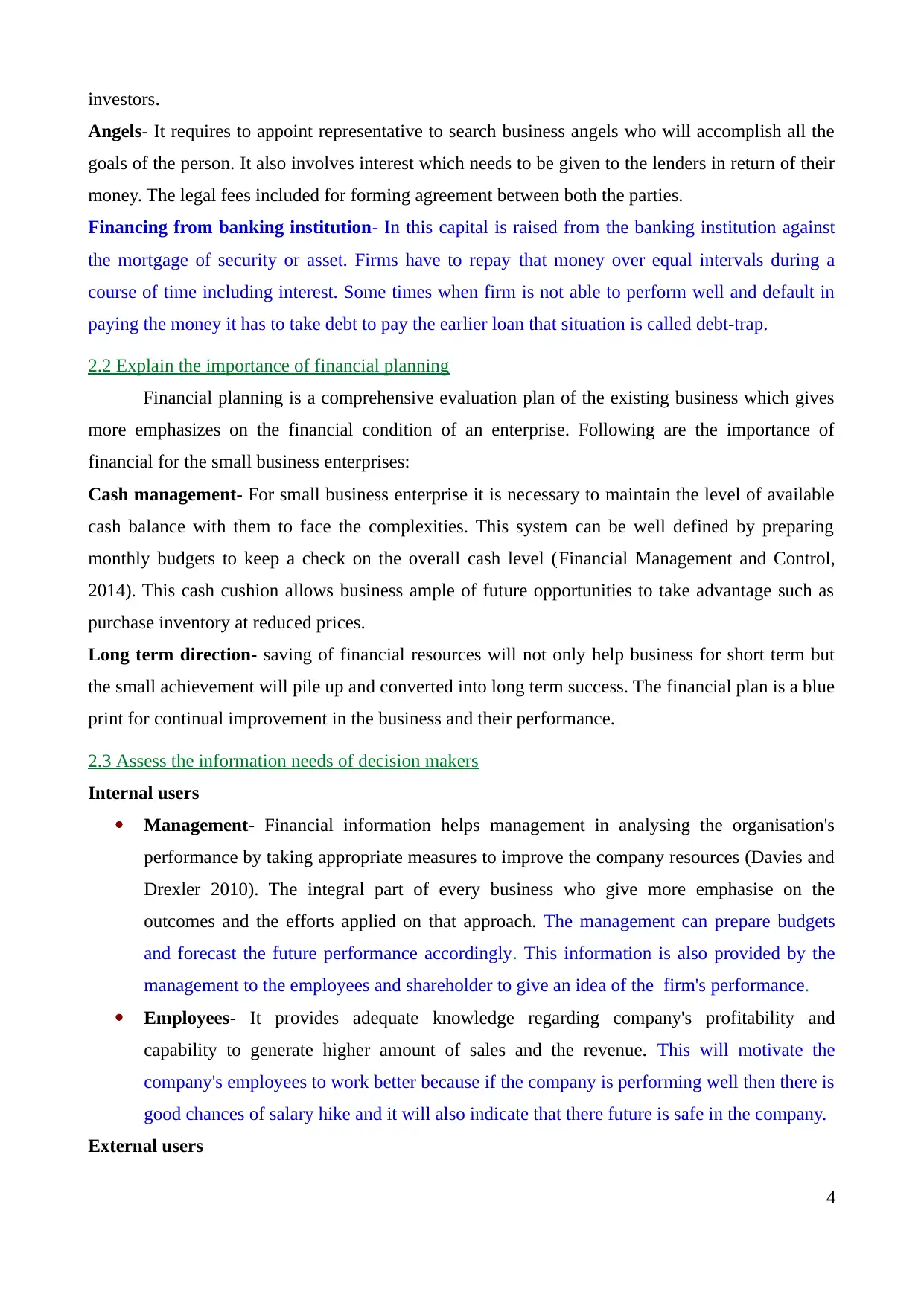
investors.
Angels- It requires to appoint representative to search business angels who will accomplish all the
goals of the person. It also involves interest which needs to be given to the lenders in return of their
money. The legal fees included for forming agreement between both the parties.
Financing from banking institution- In this capital is raised from the banking institution against
the mortgage of security or asset. Firms have to repay that money over equal intervals during a
course of time including interest. Some times when firm is not able to perform well and default in
paying the money it has to take debt to pay the earlier loan that situation is called debt-trap.
2.2 Explain the importance of financial planning
Financial planning is a comprehensive evaluation plan of the existing business which gives
more emphasizes on the financial condition of an enterprise. Following are the importance of
financial for the small business enterprises:
Cash management- For small business enterprise it is necessary to maintain the level of available
cash balance with them to face the complexities. This system can be well defined by preparing
monthly budgets to keep a check on the overall cash level (Financial Management and Control,
2014). This cash cushion allows business ample of future opportunities to take advantage such as
purchase inventory at reduced prices.
Long term direction- saving of financial resources will not only help business for short term but
the small achievement will pile up and converted into long term success. The financial plan is a blue
print for continual improvement in the business and their performance.
2.3 Assess the information needs of decision makers
Internal users
Management- Financial information helps management in analysing the organisation's
performance by taking appropriate measures to improve the company resources (Davies and
Drexler 2010). The integral part of every business who give more emphasise on the
outcomes and the efforts applied on that approach. The management can prepare budgets
and forecast the future performance accordingly. This information is also provided by the
management to the employees and shareholder to give an idea of the firm's performance.
Employees- It provides adequate knowledge regarding company's profitability and
capability to generate higher amount of sales and the revenue. This will motivate the
company's employees to work better because if the company is performing well then there is
good chances of salary hike and it will also indicate that there future is safe in the company.
External users
4
Angels- It requires to appoint representative to search business angels who will accomplish all the
goals of the person. It also involves interest which needs to be given to the lenders in return of their
money. The legal fees included for forming agreement between both the parties.
Financing from banking institution- In this capital is raised from the banking institution against
the mortgage of security or asset. Firms have to repay that money over equal intervals during a
course of time including interest. Some times when firm is not able to perform well and default in
paying the money it has to take debt to pay the earlier loan that situation is called debt-trap.
2.2 Explain the importance of financial planning
Financial planning is a comprehensive evaluation plan of the existing business which gives
more emphasizes on the financial condition of an enterprise. Following are the importance of
financial for the small business enterprises:
Cash management- For small business enterprise it is necessary to maintain the level of available
cash balance with them to face the complexities. This system can be well defined by preparing
monthly budgets to keep a check on the overall cash level (Financial Management and Control,
2014). This cash cushion allows business ample of future opportunities to take advantage such as
purchase inventory at reduced prices.
Long term direction- saving of financial resources will not only help business for short term but
the small achievement will pile up and converted into long term success. The financial plan is a blue
print for continual improvement in the business and their performance.
2.3 Assess the information needs of decision makers
Internal users
Management- Financial information helps management in analysing the organisation's
performance by taking appropriate measures to improve the company resources (Davies and
Drexler 2010). The integral part of every business who give more emphasise on the
outcomes and the efforts applied on that approach. The management can prepare budgets
and forecast the future performance accordingly. This information is also provided by the
management to the employees and shareholder to give an idea of the firm's performance.
Employees- It provides adequate knowledge regarding company's profitability and
capability to generate higher amount of sales and the revenue. This will motivate the
company's employees to work better because if the company is performing well then there is
good chances of salary hike and it will also indicate that there future is safe in the company.
External users
4
Paraphrase This Document
Need a fresh take? Get an instant paraphrase of this document with our AI Paraphraser
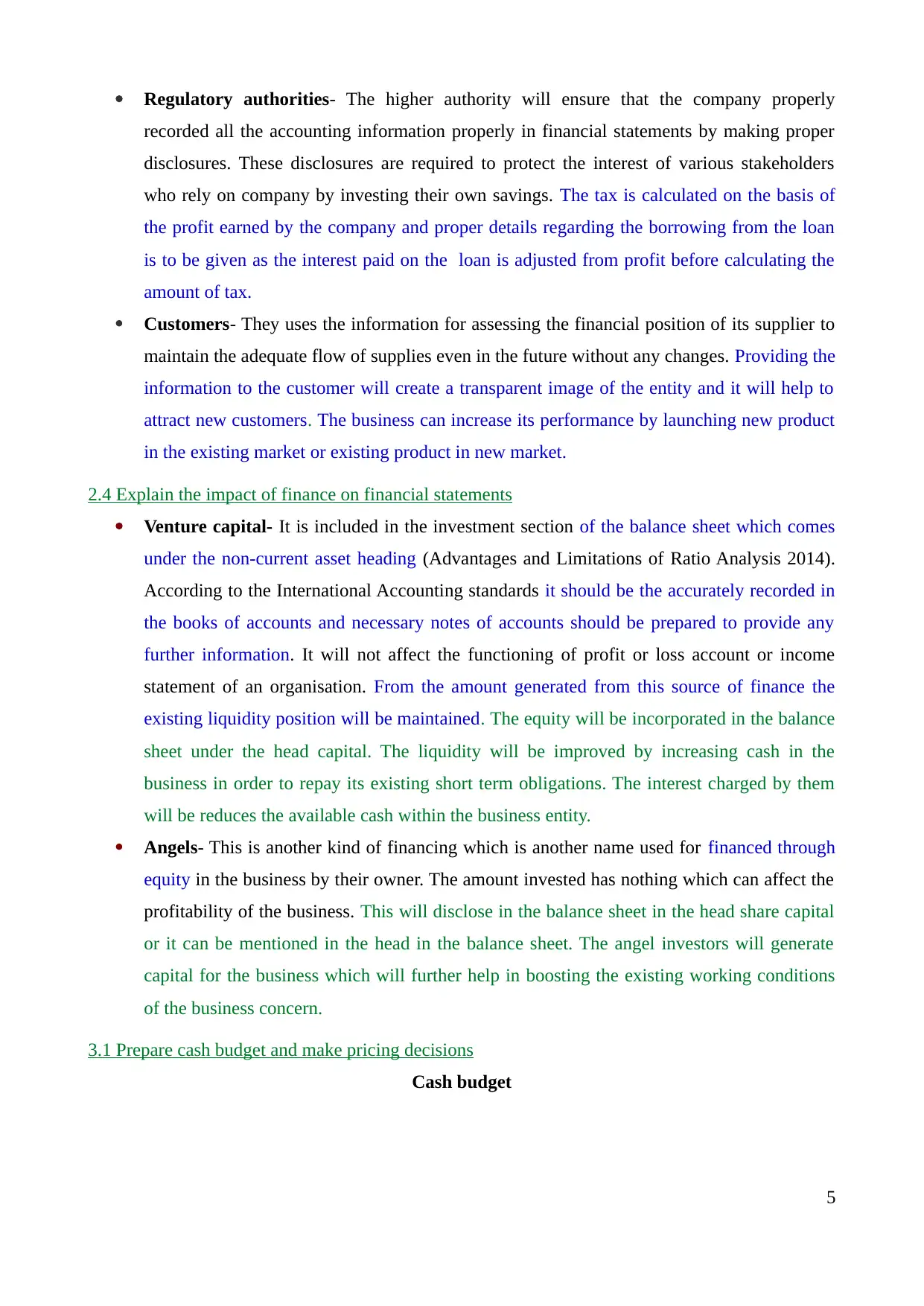
Regulatory authorities- The higher authority will ensure that the company properly
recorded all the accounting information properly in financial statements by making proper
disclosures. These disclosures are required to protect the interest of various stakeholders
who rely on company by investing their own savings. The tax is calculated on the basis of
the profit earned by the company and proper details regarding the borrowing from the loan
is to be given as the interest paid on the loan is adjusted from profit before calculating the
amount of tax.
Customers- They uses the information for assessing the financial position of its supplier to
maintain the adequate flow of supplies even in the future without any changes. Providing the
information to the customer will create a transparent image of the entity and it will help to
attract new customers. The business can increase its performance by launching new product
in the existing market or existing product in new market.
2.4 Explain the impact of finance on financial statements
Venture capital- It is included in the investment section of the balance sheet which comes
under the non-current asset heading (Advantages and Limitations of Ratio Analysis 2014).
According to the International Accounting standards it should be the accurately recorded in
the books of accounts and necessary notes of accounts should be prepared to provide any
further information. It will not affect the functioning of profit or loss account or income
statement of an organisation. From the amount generated from this source of finance the
existing liquidity position will be maintained. The equity will be incorporated in the balance
sheet under the head capital. The liquidity will be improved by increasing cash in the
business in order to repay its existing short term obligations. The interest charged by them
will be reduces the available cash within the business entity.
Angels- This is another kind of financing which is another name used for financed through
equity in the business by their owner. The amount invested has nothing which can affect the
profitability of the business. This will disclose in the balance sheet in the head share capital
or it can be mentioned in the head in the balance sheet. The angel investors will generate
capital for the business which will further help in boosting the existing working conditions
of the business concern.
3.1 Prepare cash budget and make pricing decisions
Cash budget
5
recorded all the accounting information properly in financial statements by making proper
disclosures. These disclosures are required to protect the interest of various stakeholders
who rely on company by investing their own savings. The tax is calculated on the basis of
the profit earned by the company and proper details regarding the borrowing from the loan
is to be given as the interest paid on the loan is adjusted from profit before calculating the
amount of tax.
Customers- They uses the information for assessing the financial position of its supplier to
maintain the adequate flow of supplies even in the future without any changes. Providing the
information to the customer will create a transparent image of the entity and it will help to
attract new customers. The business can increase its performance by launching new product
in the existing market or existing product in new market.
2.4 Explain the impact of finance on financial statements
Venture capital- It is included in the investment section of the balance sheet which comes
under the non-current asset heading (Advantages and Limitations of Ratio Analysis 2014).
According to the International Accounting standards it should be the accurately recorded in
the books of accounts and necessary notes of accounts should be prepared to provide any
further information. It will not affect the functioning of profit or loss account or income
statement of an organisation. From the amount generated from this source of finance the
existing liquidity position will be maintained. The equity will be incorporated in the balance
sheet under the head capital. The liquidity will be improved by increasing cash in the
business in order to repay its existing short term obligations. The interest charged by them
will be reduces the available cash within the business entity.
Angels- This is another kind of financing which is another name used for financed through
equity in the business by their owner. The amount invested has nothing which can affect the
profitability of the business. This will disclose in the balance sheet in the head share capital
or it can be mentioned in the head in the balance sheet. The angel investors will generate
capital for the business which will further help in boosting the existing working conditions
of the business concern.
3.1 Prepare cash budget and make pricing decisions
Cash budget
5

A Cash Budget is prepared by the entity to make a estimate of its future cash inflows and
cash outflows for a business over a period of time. The concept of cash budget help us to
understand that if the entity has enough cash to maintain its current business operation over given
period of time. The company use revenue and production forecast to make cash budget. Under the
inflow part we include revenue collected, any money received from financing and under outflow
part we include expense or payment made. Cash budget helps the business owners to pre-plan that
how much revenue is to be required by the enity to cover its expenses and generate profit.
Explanation:
Above budget reflects that the firm is unable to perform well as the amount of expenses is
more than the sales made by the firm. Following are the division of the budget on basis of different
months :
The entrepreneur started making the budget in the month January with the initial capital of 20000
and further 60000 has been raised from bank loan to fund the business projects. From the very
beginning the company started to make loss as the amount generated by the company is far less than
the amount spent by the company. The condition of the company has not improved in February and
March as well but the losses generated by the company has fallen monthly . April is the only month
in which company has generated any profit due to the reason that high amount comes from disposal
of assets and interest receivables that are in total 6,00,000 which induce the level of cash inflow
6
cash outflows for a business over a period of time. The concept of cash budget help us to
understand that if the entity has enough cash to maintain its current business operation over given
period of time. The company use revenue and production forecast to make cash budget. Under the
inflow part we include revenue collected, any money received from financing and under outflow
part we include expense or payment made. Cash budget helps the business owners to pre-plan that
how much revenue is to be required by the enity to cover its expenses and generate profit.
Explanation:
Above budget reflects that the firm is unable to perform well as the amount of expenses is
more than the sales made by the firm. Following are the division of the budget on basis of different
months :
The entrepreneur started making the budget in the month January with the initial capital of 20000
and further 60000 has been raised from bank loan to fund the business projects. From the very
beginning the company started to make loss as the amount generated by the company is far less than
the amount spent by the company. The condition of the company has not improved in February and
March as well but the losses generated by the company has fallen monthly . April is the only month
in which company has generated any profit due to the reason that high amount comes from disposal
of assets and interest receivables that are in total 6,00,000 which induce the level of cash inflow
6
⊘ This is a preview!⊘
Do you want full access?
Subscribe today to unlock all pages.

Trusted by 1+ million students worldwide
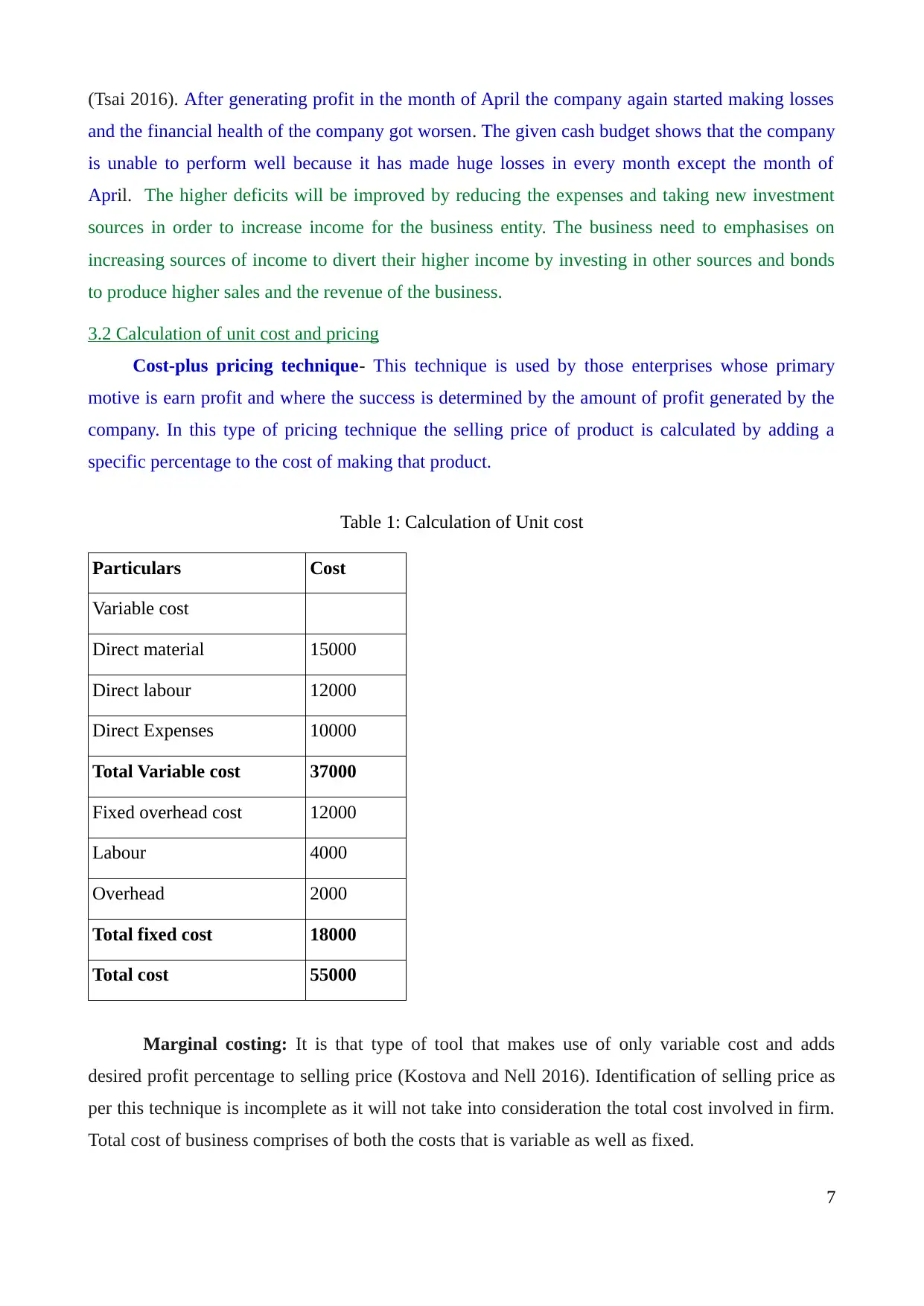
(Tsai 2016). After generating profit in the month of April the company again started making losses
and the financial health of the company got worsen. The given cash budget shows that the company
is unable to perform well because it has made huge losses in every month except the month of
April. The higher deficits will be improved by reducing the expenses and taking new investment
sources in order to increase income for the business entity. The business need to emphasises on
increasing sources of income to divert their higher income by investing in other sources and bonds
to produce higher sales and the revenue of the business.
3.2 Calculation of unit cost and pricing
Cost-plus pricing technique- This technique is used by those enterprises whose primary
motive is earn profit and where the success is determined by the amount of profit generated by the
company. In this type of pricing technique the selling price of product is calculated by adding a
specific percentage to the cost of making that product.
Table 1: Calculation of Unit cost
Particulars Cost
Variable cost
Direct material 15000
Direct labour 12000
Direct Expenses 10000
Total Variable cost 37000
Fixed overhead cost 12000
Labour 4000
Overhead 2000
Total fixed cost 18000
Total cost 55000
Marginal costing: It is that type of tool that makes use of only variable cost and adds
desired profit percentage to selling price (Kostova and Nell 2016). Identification of selling price as
per this technique is incomplete as it will not take into consideration the total cost involved in firm.
Total cost of business comprises of both the costs that is variable as well as fixed.
7
and the financial health of the company got worsen. The given cash budget shows that the company
is unable to perform well because it has made huge losses in every month except the month of
April. The higher deficits will be improved by reducing the expenses and taking new investment
sources in order to increase income for the business entity. The business need to emphasises on
increasing sources of income to divert their higher income by investing in other sources and bonds
to produce higher sales and the revenue of the business.
3.2 Calculation of unit cost and pricing
Cost-plus pricing technique- This technique is used by those enterprises whose primary
motive is earn profit and where the success is determined by the amount of profit generated by the
company. In this type of pricing technique the selling price of product is calculated by adding a
specific percentage to the cost of making that product.
Table 1: Calculation of Unit cost
Particulars Cost
Variable cost
Direct material 15000
Direct labour 12000
Direct Expenses 10000
Total Variable cost 37000
Fixed overhead cost 12000
Labour 4000
Overhead 2000
Total fixed cost 18000
Total cost 55000
Marginal costing: It is that type of tool that makes use of only variable cost and adds
desired profit percentage to selling price (Kostova and Nell 2016). Identification of selling price as
per this technique is incomplete as it will not take into consideration the total cost involved in firm.
Total cost of business comprises of both the costs that is variable as well as fixed.
7
Paraphrase This Document
Need a fresh take? Get an instant paraphrase of this document with our AI Paraphraser
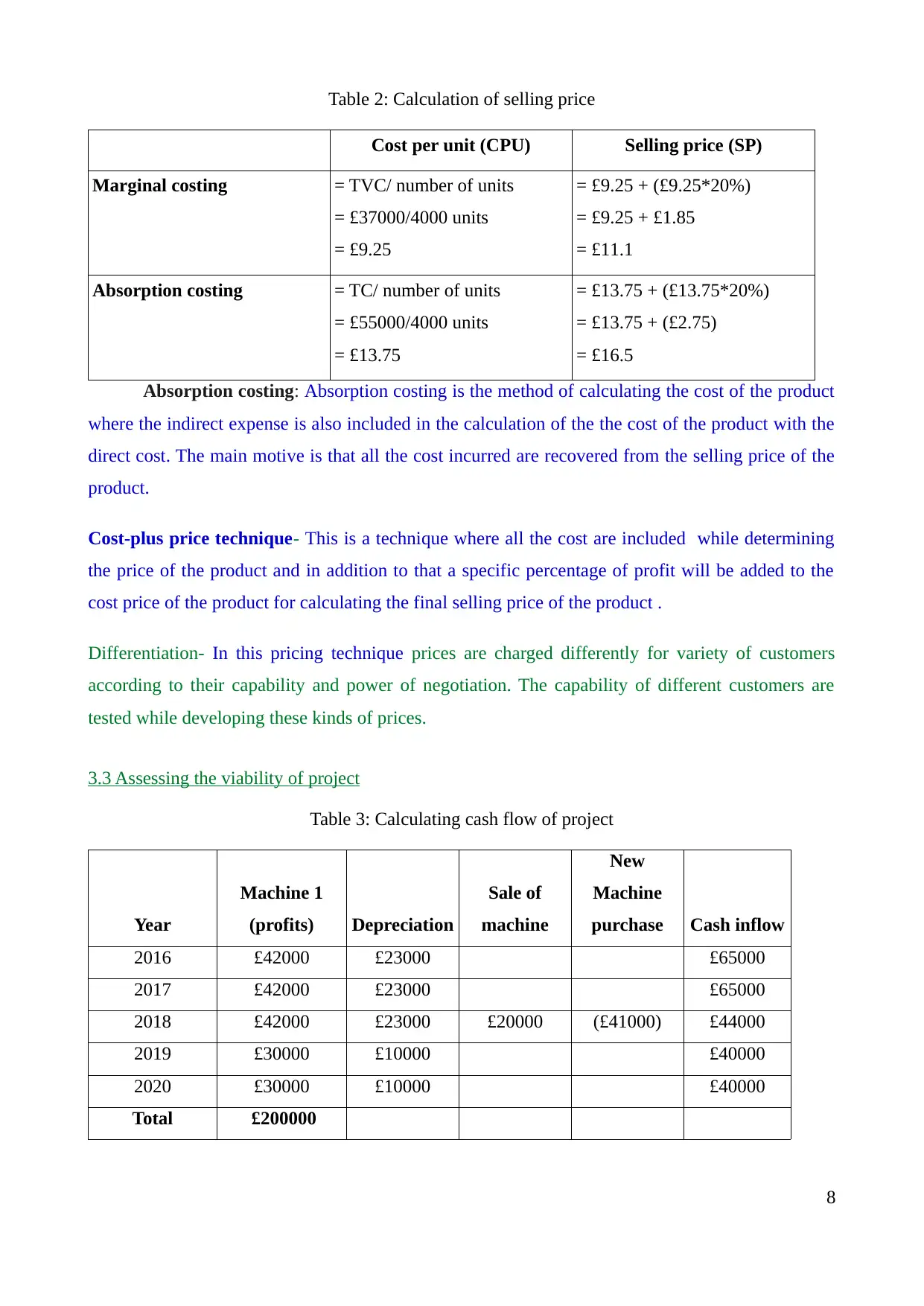
Table 2: Calculation of selling price
Cost per unit (CPU) Selling price (SP)
Marginal costing = TVC/ number of units
= £37000/4000 units
= £9.25
= £9.25 + (£9.25*20%)
= £9.25 + £1.85
= £11.1
Absorption costing = TC/ number of units
= £55000/4000 units
= £13.75
= £13.75 + (£13.75*20%)
= £13.75 + (£2.75)
= £16.5
Absorption costing: Absorption costing is the method of calculating the cost of the product
where the indirect expense is also included in the calculation of the the cost of the product with the
direct cost. The main motive is that all the cost incurred are recovered from the selling price of the
product.
Cost-plus price technique- This is a technique where all the cost are included while determining
the price of the product and in addition to that a specific percentage of profit will be added to the
cost price of the product for calculating the final selling price of the product .
Differentiation- In this pricing technique prices are charged differently for variety of customers
according to their capability and power of negotiation. The capability of different customers are
tested while developing these kinds of prices.
3.3 Assessing the viability of project
Table 3: Calculating cash flow of project
Year
Machine 1
(profits) Depreciation
Sale of
machine
New
Machine
purchase Cash inflow
2016 £42000 £23000 £65000
2017 £42000 £23000 £65000
2018 £42000 £23000 £20000 (£41000) £44000
2019 £30000 £10000 £40000
2020 £30000 £10000 £40000
Total £200000
8
Cost per unit (CPU) Selling price (SP)
Marginal costing = TVC/ number of units
= £37000/4000 units
= £9.25
= £9.25 + (£9.25*20%)
= £9.25 + £1.85
= £11.1
Absorption costing = TC/ number of units
= £55000/4000 units
= £13.75
= £13.75 + (£13.75*20%)
= £13.75 + (£2.75)
= £16.5
Absorption costing: Absorption costing is the method of calculating the cost of the product
where the indirect expense is also included in the calculation of the the cost of the product with the
direct cost. The main motive is that all the cost incurred are recovered from the selling price of the
product.
Cost-plus price technique- This is a technique where all the cost are included while determining
the price of the product and in addition to that a specific percentage of profit will be added to the
cost price of the product for calculating the final selling price of the product .
Differentiation- In this pricing technique prices are charged differently for variety of customers
according to their capability and power of negotiation. The capability of different customers are
tested while developing these kinds of prices.
3.3 Assessing the viability of project
Table 3: Calculating cash flow of project
Year
Machine 1
(profits) Depreciation
Sale of
machine
New
Machine
purchase Cash inflow
2016 £42000 £23000 £65000
2017 £42000 £23000 £65000
2018 £42000 £23000 £20000 (£41000) £44000
2019 £30000 £10000 £40000
2020 £30000 £10000 £40000
Total £200000
8
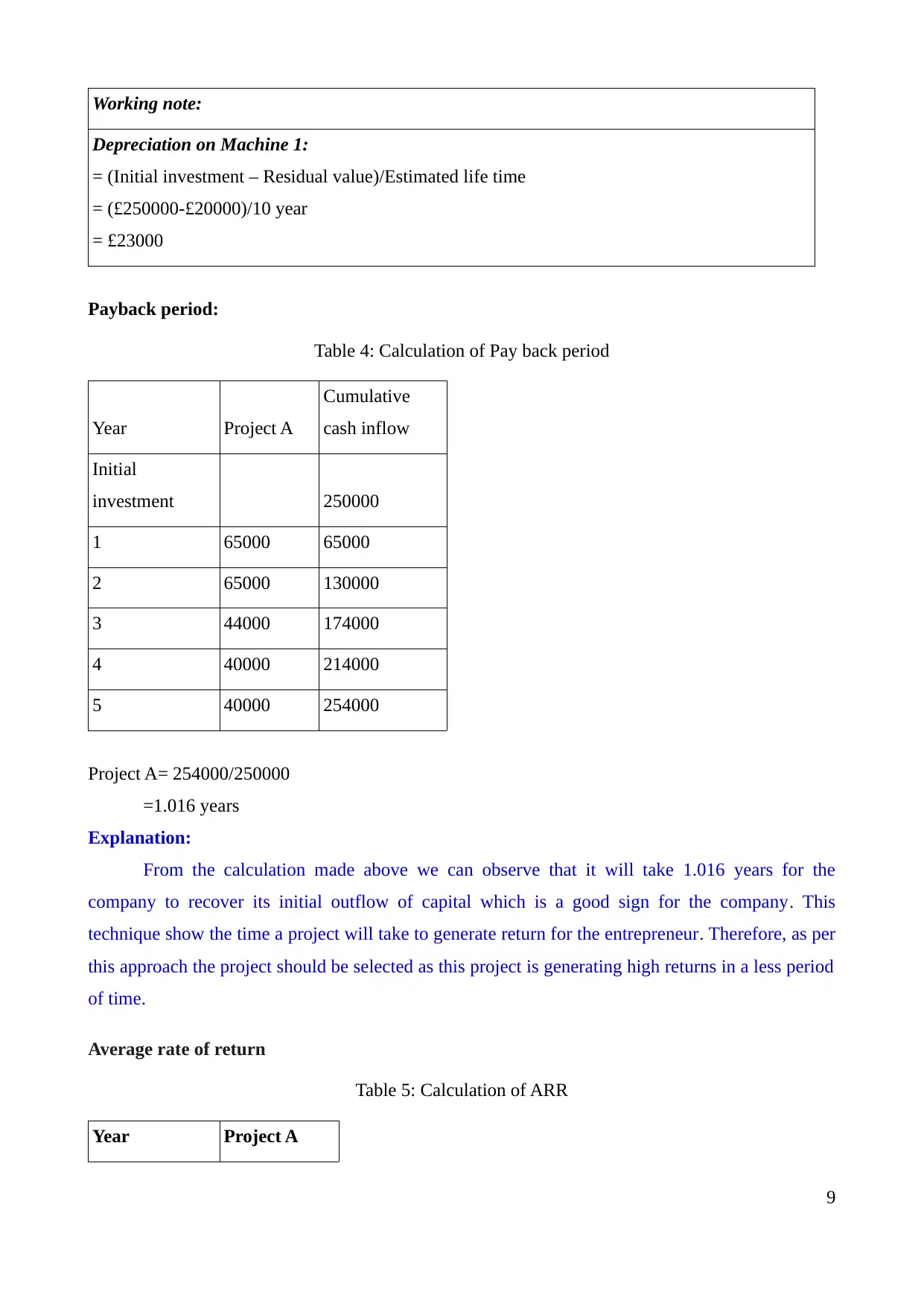
Working note:
Depreciation on Machine 1:
= (Initial investment – Residual value)/Estimated life time
= (£250000-£20000)/10 year
= £23000
Payback period:
Table 4: Calculation of Pay back period
Year Project A
Cumulative
cash inflow
Initial
investment 250000
1 65000 65000
2 65000 130000
3 44000 174000
4 40000 214000
5 40000 254000
Project A= 254000/250000
=1.016 years
Explanation:
From the calculation made above we can observe that it will take 1.016 years for the
company to recover its initial outflow of capital which is a good sign for the company. This
technique show the time a project will take to generate return for the entrepreneur. Therefore, as per
this approach the project should be selected as this project is generating high returns in a less period
of time.
Average rate of return
Table 5: Calculation of ARR
Year Project A
9
Depreciation on Machine 1:
= (Initial investment – Residual value)/Estimated life time
= (£250000-£20000)/10 year
= £23000
Payback period:
Table 4: Calculation of Pay back period
Year Project A
Cumulative
cash inflow
Initial
investment 250000
1 65000 65000
2 65000 130000
3 44000 174000
4 40000 214000
5 40000 254000
Project A= 254000/250000
=1.016 years
Explanation:
From the calculation made above we can observe that it will take 1.016 years for the
company to recover its initial outflow of capital which is a good sign for the company. This
technique show the time a project will take to generate return for the entrepreneur. Therefore, as per
this approach the project should be selected as this project is generating high returns in a less period
of time.
Average rate of return
Table 5: Calculation of ARR
Year Project A
9
⊘ This is a preview!⊘
Do you want full access?
Subscribe today to unlock all pages.

Trusted by 1+ million students worldwide
1 out of 17
Related Documents
Your All-in-One AI-Powered Toolkit for Academic Success.
+13062052269
info@desklib.com
Available 24*7 on WhatsApp / Email
![[object Object]](/_next/static/media/star-bottom.7253800d.svg)
Unlock your academic potential
Copyright © 2020–2025 A2Z Services. All Rights Reserved. Developed and managed by ZUCOL.





